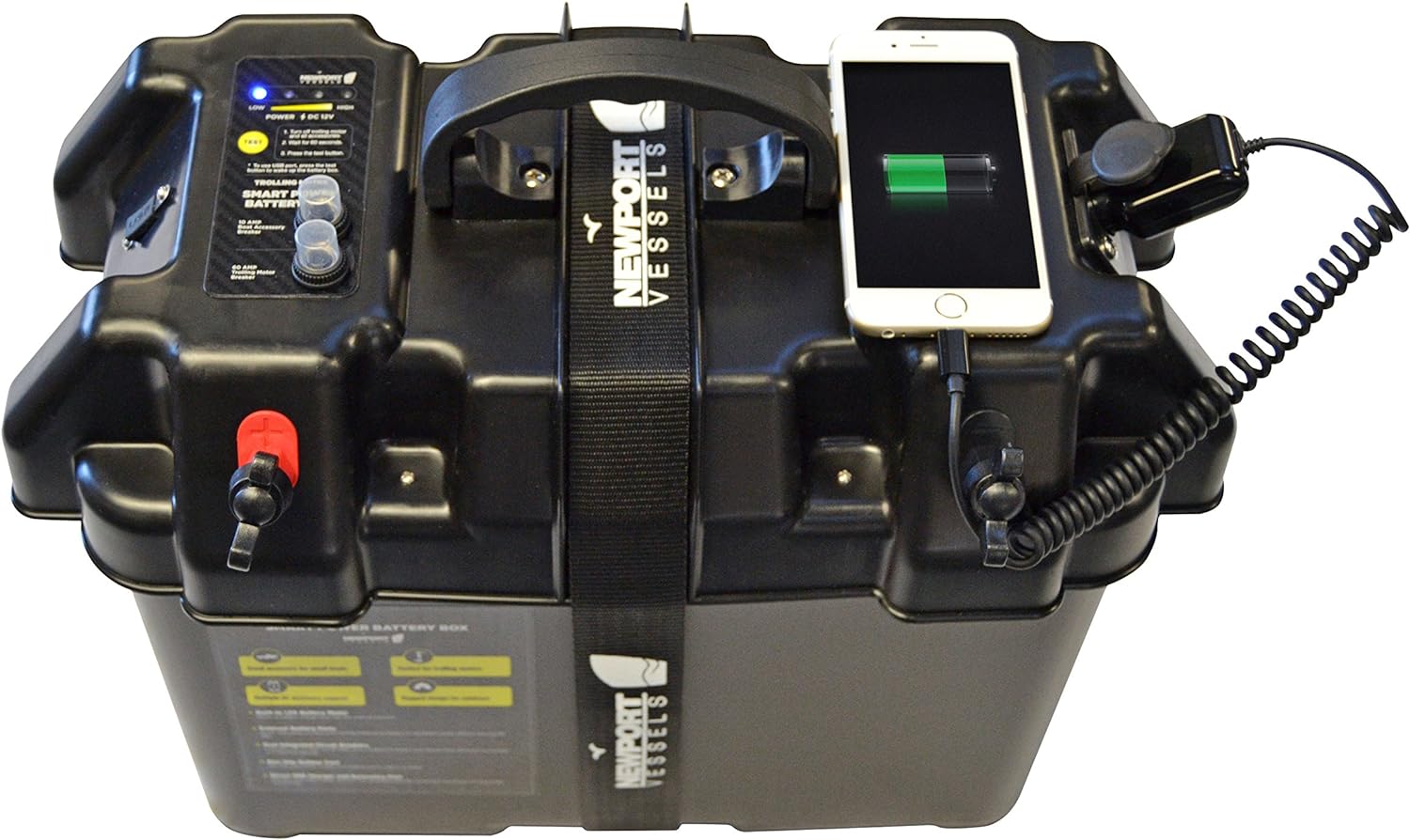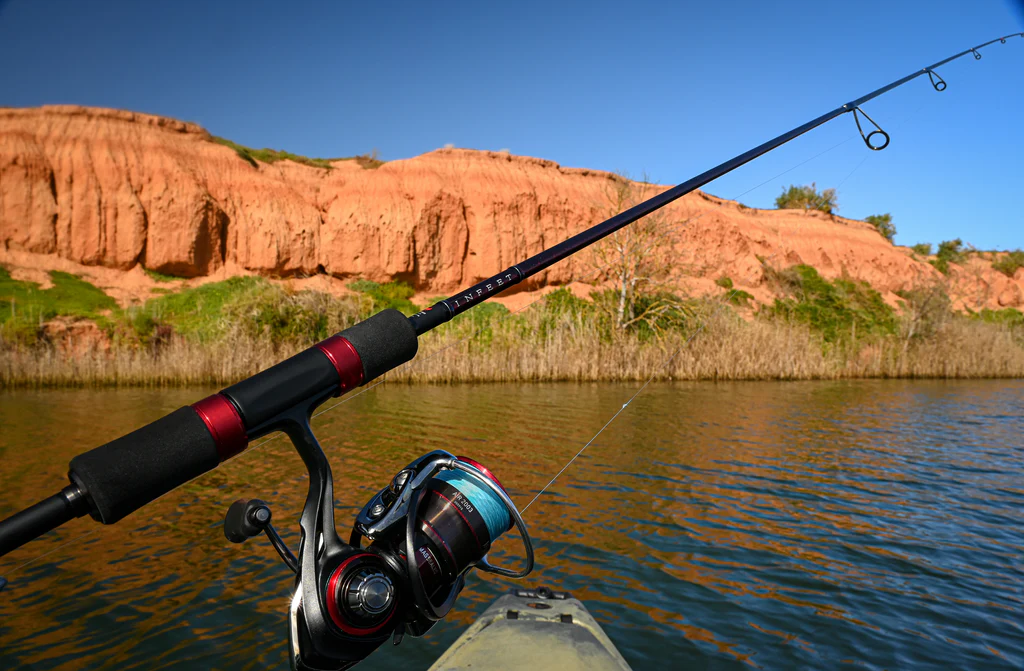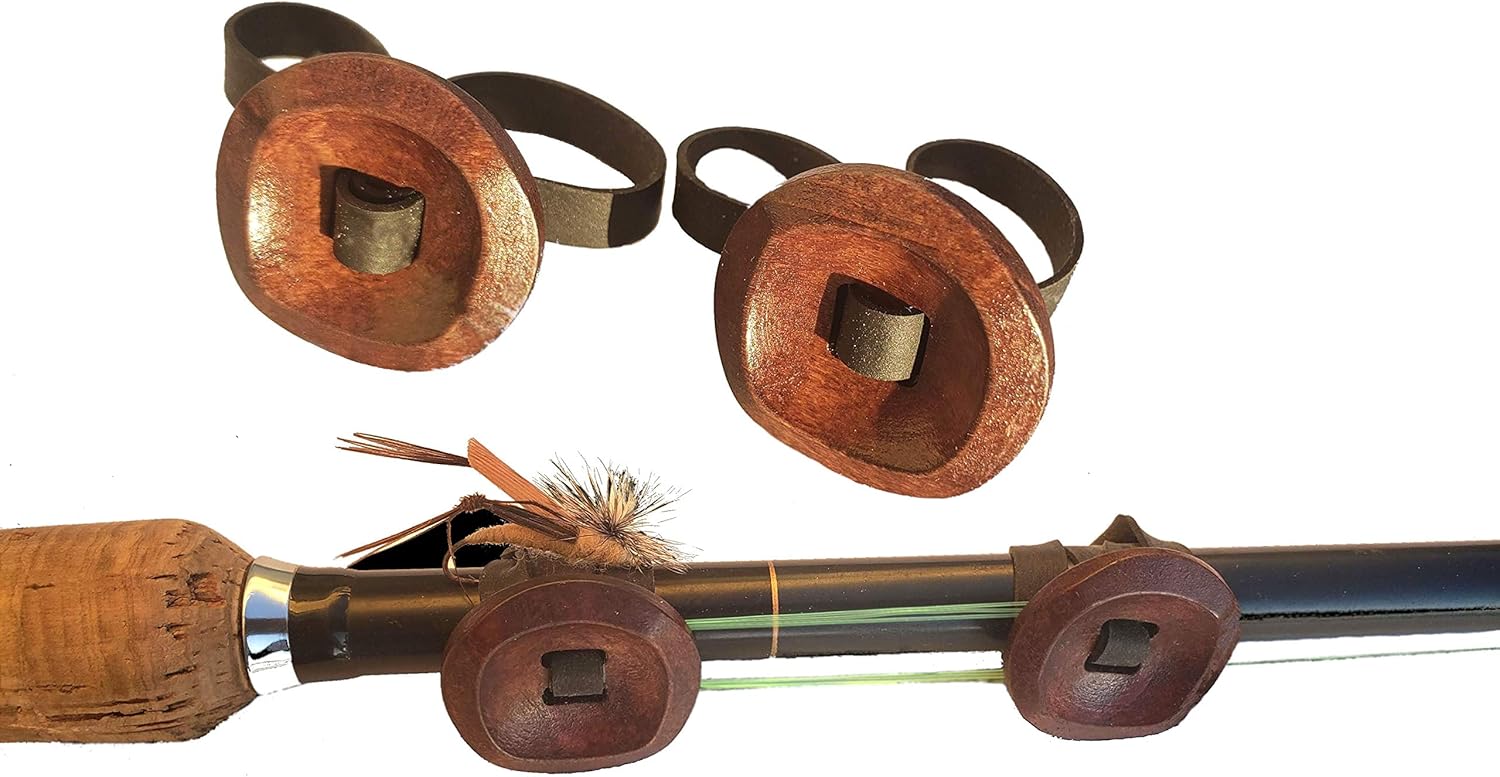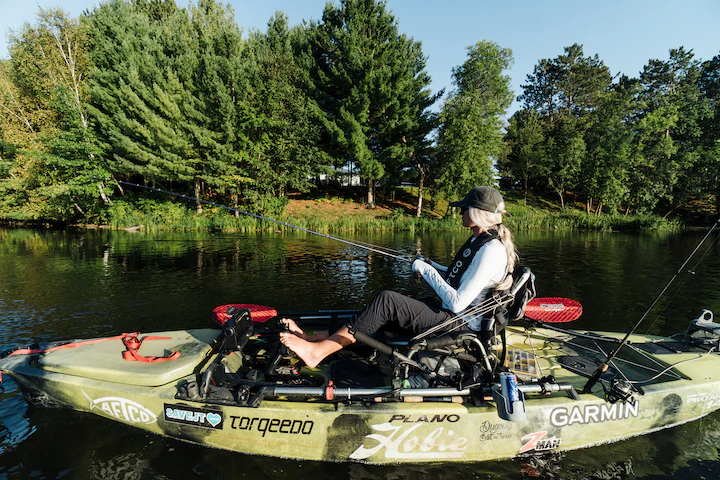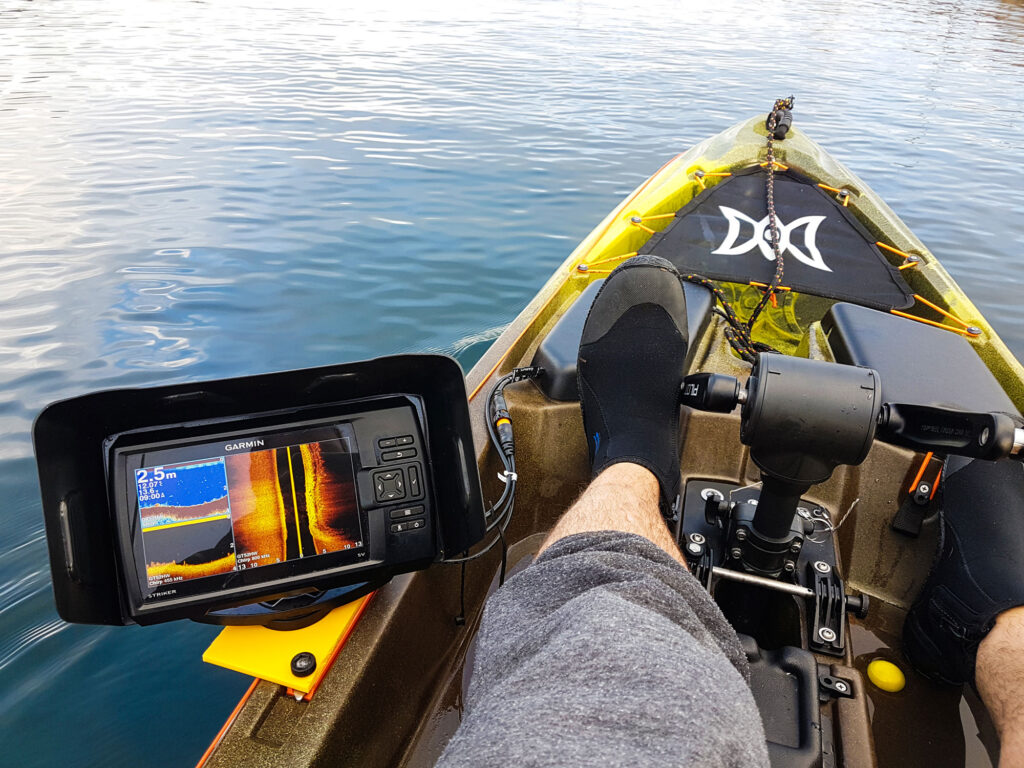Table of Contents
A correctly sized trolling motor is powerful enough to move the boat consistently without straining it. This will extend the motor’s life and optimize battery use.
Choosing an electric trolling motor can be complex, especially for beginners. This guide aims to simplify the process. It will help you match the features to your needs and your boat’s specs. Once you’ve bought the best trolling motor, it’s time to explore how to correctly size it.
What is a trolling motor?
A trolling motor is a motor either an electric boat motor or gasoline which provides a way of propulsion of a fishing boat which is called trolling. The trolling motor is the opposite of the outboard motor. Fishers use the outboard to boost power. They use the trolling motor to move about their boats slowly and efficiently.
Trolling motors can either be bow-mounted or stern-mounted. Bow-mounted types are a staple in freshwater fishing boats. Stern-mounted models are better for saltwater fishing and small boats.
Choosing between an electric or gas trolling motor depends on your needs. These include your boat’s size and the duration of your fishing trip. Electric trolling motors are popular for freshwater fishing. They are silent, easy to use, and low-polluting.
Boats with gas-driven motors could be favored for larger boats or when longer service time is needed particularly in the fishing area. Knowing these differences will help you choose the right motor trolling. It will make your fishing activities fun on the water even with your small trolling motor.
What size trolling motor do you need?
Generally, the best thrust for trolling motors is about 2 pounds of pressured water per 100 pounds of total boat weight as a general guideline. On the other hand, if you plan on tackling fierce winds or currents you will need a great power output.
In similar cases, adding 10 to 15 percent extra to the main motor is vital. It helps achieve the highest output.
It should be remembered that vessels with a big draught of water show more mechanical resistance compared to those with shallow draught; hence, bigger motor power is required in the first case.
Also, boats with raised decks, like pontoon boats, are more exposed to the wind. They need more thrust to fight it.
Therefore, specifying the exact thrust for your unique circumstances may realize that there is much more to it than the initial calculations indicated.
If you can’t decide, choose a trolling motor with too much power. An underpowered one can be hard to use at times.
Trolling motor size chart
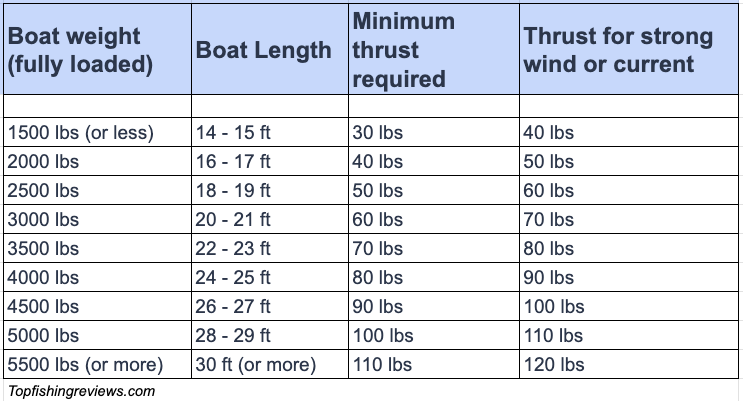
The table shows the ounces of trolling motor thrust that are required as a basis of the boat’s length and weight. Column number 3 refers to the minimum thrust adequate for all boat sizes in the group. Strong wind or current can be dealt with with the upper thrust levels enumerated in column number 4.
Usually, you need to overshoot your thrust just slightly rather than undershoot. That way, when something unpredictable happens, you will have more opportunity to adjust it successfully.
Moreover, the following table approximates an average boat price. Furthermore, alongside wind and tide effects, your boat type determines the sufficient amount of thrust to depend on.
Motor size for a bass boat
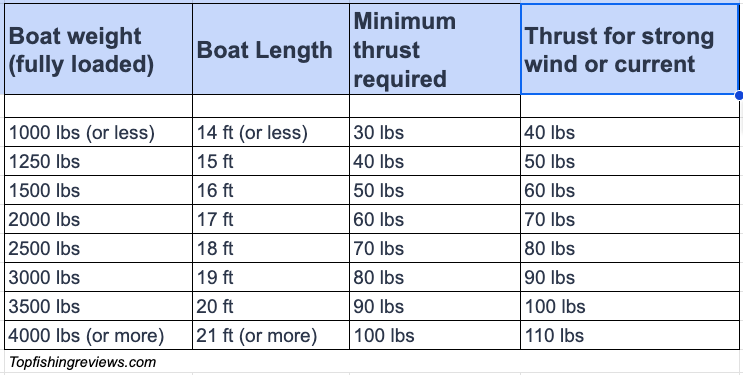
The bass boats, unlike other boat types, are often lighter even though they are similar in length. Much of the bass fishing community purposely goes for maximum trolling motor thrust capacity which can vary in size from 80 to 120 lbs.
Bass boat fishermen are agile, and they can use their trolling motors in different locations, e.g., spillways, the river’s current, or a wind-swept flat.
Furthermore, larger trolling motor batteries ensure that the boats can be powered by 24V or 36V batteries that are often brought to fishing tournaments to get even more results.
Motor size of Jon boat
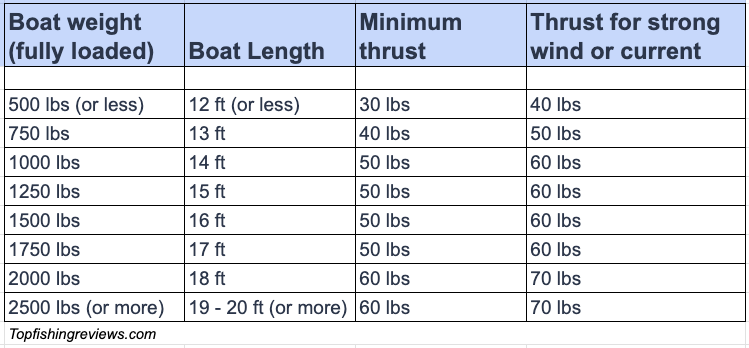
The table above displays the suggested thrust for varying Jon boat sizes. Jon boats are generally lightweight, making a 45 to 55 lbs thrust trolling motor sufficient. An exception is when carrying many passengers on larger Jon boats, where a 70 to 80-lb thrust motor is more suitable.
How is trolling motor shaft length measured?
The length of the trolling motor shaft is a sophisticated parameter which is directly impacting the performance of the motor. This length relates to the measurement of the motor part from the base of the head of the motor down to where the compartment of the motor ends. The additional technique, however, lies in taking not from the lowermost unit to the top unit.
The accuracy of this measurement is of major importance as it directly relates to the proper operation of the trolling rudder. A recent approach in figuring out the shaft’s length would be to attend to the surface where the motor is mounted and from there down to the surface.
For specific measurements, if you have a measurement in the range of 22 to 28 inches and you need to pick a shaft length, you can go with 45 to 52 inches. On the other hand, if you want to measure 28 to 34 inches, then a shaft length of 54 to 62 inches will be suitable for you.
Can a motor shaft be too long?
Yes, you may have an overly long trolling motor shaft. The length of the rod is the most important factor when looking at the frame of the trolling motor.
Having a shaft that is too long can cause problems as it can strike a buried reef or bottom of the water body’s bottom and increase passing over due to the impact it experiences.
While this, too, needs to be considered, it is also vital to realize that a longer rod consumes more space in storage. But, it’s generally better if the shaft is a little longer since this can be adjusted up or down during the installation process.
Thus, deciding on the appropriate shaft length for your motor is demanding. The rule of thumb is that at least 1 foot of water should overlap the top of the foot of the motor section.
Motor battery size
The correct choice of the right battery for your trolling motor is a complex procedure, so many things must be reflected upon. A major contributor here is the size of the trolling motor battery which must be selected according to your boat size and the trolling motor’s power demands.
The most common trolling motor battery groups are 24, 27, and 31. In this matter, the proper size would be based on the size of your boat.
Say you are using a new port vessel 55-lb motor for two hours, at full speed, hence you will require a 100-120 AH (ampere-hour) battery rating. On the other hand, boats of weight between 3,000lb and – 4,000 lbs are likely to possess two 24v batteries for this purpose.
The battery is also one of the most decisive parts. For example, a 12-volt deep cycle marine battery at least with a 110 amp hour rating is a preferred item in most cases. Turnout of Group 27 dimension or bigger is generally favored because they offer more capacity.
Select a battery with a 100 amperage hour rating and Group 27 classification that provides Reserve Capacity (RC) for no less than 175 minutes for trolling motor application. Among bass anglers, the most popular 12V 50Ah and 12V 100Ah battery models are seen as the best options when potent lithium one is considered.
In the end, the number of batteries you need depends on the trolling motor that you use. That means if the motor has 55 lbs. regardless of whether you need a lot of thrust/less, one 12-volt battery is usually enough.
What is the best battery for a trolling motor?
The Newport Trolling Motor Smart Battery Box Power Center is a versatile and innovative solution for power needs, especially marine applications. While it is ready for 12V battery (not included) installation, this battery box offers a variety of features. This case serves not only as a battery-safe and handy charging station but also as a complete power source.
The battery box provides a USB and 12V DC power outlet, hence it is possible to charge your gadgets in the middle of a water journey. Big enough to put in the battery and other tools too, the box will become quite a useful accessory.
Intelligence is the reason this battery box stands out. It also contains an LED meter, which functions much like the battery charge indicator on smartphones, operating as a source of live data about the status of the battery.
In terms of its performance, it has been rated very high by customers with one customer stating that it can put out 100 amps while the other 20 amps. More than that it’s been listed as #1 “Best Seller” among trolling motors on Amazon.com.
Wrapping up!
We hope this blog has helped you understand how to size a trolling motor correctly and choose the best battery for your needs. Remember to consider factors such as thrust, boat weight, and battery capacity when making your decision. And don’t forget about accessories like battery boxes and chargers to keep your trolling motor running smoothly.

